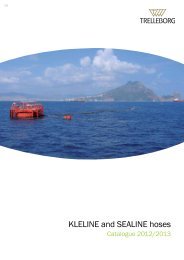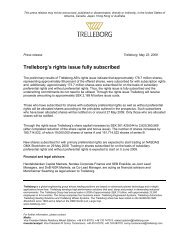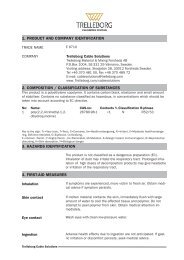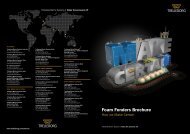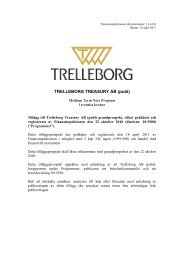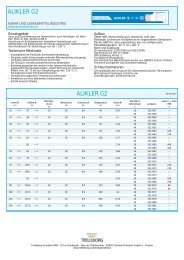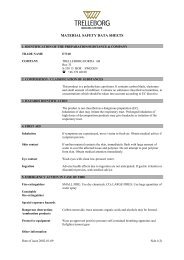Annual report 2011 - Trelleborg
Annual report 2011 - Trelleborg
Annual report 2011 - Trelleborg
Create successful ePaper yourself
Turn your PDF publications into a flip-book with our unique Google optimized e-Paper software.
Moreover, because selected parts of risk<br />
management activities are Group-wide,<br />
the central Group resources can be allocated<br />
to prioritized risk focus areas.<br />
Group Treasury is responsible for<br />
financial risk management activities.<br />
The unit is in charge of Group companies’<br />
external bank relations, liquidity<br />
management, net financial items,<br />
interest- bearing liabilities and assets,<br />
Group-wide payment systems and netting<br />
of currency positions. Centralization<br />
of the Group’s treasury management<br />
ensures substantial economies of scale,<br />
lower financing costs, tight management<br />
of the Group’s financial risks and<br />
improved internal control.<br />
<strong>Trelleborg</strong>’s Treasury Policy defines<br />
the financing operation’s purpose, organization<br />
and distribution of responsibility,<br />
and also prescribes a framework for<br />
financial risk management activities.<br />
The Finance Committee of the Board of<br />
Directors reviews the Treasury Policy and<br />
proposes changes annually, or more<br />
frequently if necessary, after which the<br />
Treasury Policy is adopted by the Board.<br />
<strong>Trelleborg</strong>’s Treasury Policy states,<br />
among other things, that decisions on<br />
foreign exchange hedging of operating<br />
cash flows shall be made by the respective<br />
business areas in cooperation with<br />
Group Treasury, which manages hedging<br />
activities centrally. All foreign exchange<br />
transactions of Group companies must<br />
be conducted in conjunction with Group<br />
Treasury, which ensures that the Group’s<br />
hedging activities are carried out in compliance<br />
with the <strong>Trelleborg</strong>’s Treasury<br />
Policy. Group Treasury continuously monitors<br />
key figures related to the Group’s<br />
capital structure and forecasts for the<br />
Group’s liquidity reserve are reviewed on<br />
a monthly basis.<br />
Within the scope of <strong>Trelleborg</strong>’s<br />
Treasury Policy, Group Treasury has the<br />
option to conduct a certain level of proprietary<br />
trading in currency and interestrate<br />
instruments. Such trading generated<br />
a profit in <strong>2011</strong>.<br />
<strong>Trelleborg</strong>’s risk management is<br />
systematically monitored by Group management<br />
using such tools as monthly<br />
<strong>report</strong>s from the managers in charge in<br />
which they describe developments within<br />
their respective areas of responsibility<br />
as well as identified risks. <strong>2011</strong> also<br />
marked the introduction of new <strong>report</strong>ing<br />
procedures for Enterprise Risk Management<br />
and Corporate Responsibility in<br />
which the Group’s consolidation system<br />
plays a decisive role. The Group’s<br />
General Counsel <strong>report</strong>s on a continuous<br />
basis to the Audit Committee regarding<br />
the Group’s risk activities and risk management<br />
and the Group’s CFO <strong>report</strong>s<br />
frequently to the Finance Committee<br />
concerning the Group’s finance operations,<br />
including financial risks and financial<br />
risk management. Furthermore, the<br />
President regularly provides the Board<br />
with <strong>report</strong>s on the development of the<br />
Group’s risks.<br />
ERM priorities<br />
<strong>2011</strong><br />
Within the framework of the ERM and<br />
strategy processes, the focus of the Risk<br />
Management staff function remained on<br />
jumbo risks, meaning risks that can<br />
result in damage or losses that may<br />
have significant impact on the entire<br />
Group and therefore motivate the risk<br />
being handled from a Group perspective.<br />
Risk management activities in <strong>2011</strong><br />
continued to focus on the prioritized risk<br />
area “Protection of sites that are of<br />
critical importance for the Group’s<br />
operations and earnings.” Specific action<br />
plans to significantly raise the level of<br />
protection were produced and implementation<br />
of the measures commenced at<br />
36 sites. Of these, eight facilities were<br />
designated at the Highly Protected Risk<br />
level, which is the highest risk classification.<br />
The aim is to raise a further 11<br />
sites to this level in the future.<br />
In <strong>2011</strong>, new <strong>report</strong>ing procedures<br />
were introduced for Enterprise Risk<br />
Management and Corporate Responsibility<br />
in which the Group’s consolidation<br />
system plays a decisive role. The Group’s<br />
companies, business areas and business<br />
units can use the system to systematically<br />
identify, analyze and <strong>report</strong> risks.<br />
This system is already in use in financial<br />
<strong>report</strong>ing and for <strong>report</strong>ing of work involving<br />
the internal control over the financial<br />
<strong>report</strong>ing.<br />
Activities in focus in 2012<br />
Prioritized activities for 2012:<br />
Implementation of the action plans<br />
drawn up for sites aimed at significantly<br />
raising security levels.<br />
Risk assessment of strategic<br />
suppliers.<br />
Focus on handling and storage of<br />
chemicals at manufacturing sites.<br />
Combating corruption and review<br />
of Group-wide structures, including<br />
consideration of the new UK Bribery<br />
Act.<br />
GOVERNANCE AND RESPONSIBILITY – RISKS AND RISK MANAGEMENT<br />
Risk management processes for products<br />
and solutions in environments<br />
with elevated risk levels.<br />
Strategic and operational<br />
risks<br />
Strategic and operational risks cover a<br />
number of different risk. For example,<br />
<strong>Trelleborg</strong>’s operations are influenced by<br />
political decisions and administrative<br />
regulations in some 40 countries in<br />
which it operates. These include regulations<br />
that apply to taxation and financial<br />
<strong>report</strong>ing and legislation in the environmental<br />
area. <strong>Trelleborg</strong>’s business is<br />
also affected, for example, by natural<br />
disasters, environmental impacts and<br />
external financial risks. The ability to<br />
attract and retain key personnel, the<br />
acquisition and integration of new units,<br />
divestments and structural measures<br />
are examples of additional risks encountered<br />
by <strong>Trelleborg</strong>.<br />
<strong>Trelleborg</strong>’s focus on operational<br />
risks primarily encompasses market<br />
risks, costs risks, site risks, customerrelated<br />
credit risks and IT risks.<br />
Market risks<br />
<strong>Trelleborg</strong>’s business and earnings are<br />
exposed to market risks in the form of<br />
the economy’s impact on demand for the<br />
Group’s own products and solutions.<br />
Demand for <strong>Trelleborg</strong>’s products and<br />
solutions impacts delivery volumes.<br />
The Group sells polymer-based products<br />
and solutions to a very broad spectrum<br />
of customers and sectors, with an<br />
emphasis on industry in Europe, the US<br />
and emerging markets. Demand for the<br />
Group’s products and solutions largely<br />
moves in line with fluctuations in global<br />
industrial production. Demand can<br />
generally be divided into three large<br />
segments – general industry, capital-<br />
intensive industry and light vehicles.<br />
General industry comprises a large<br />
number of products and solutions that<br />
are critical to the function of all continuous<br />
industrial processes and industrial<br />
products, providing a direct link to industrial<br />
business activity.<br />
Demand in the capital-intensive<br />
industry has greater emphasis on products<br />
and solutions connected to major<br />
industrial projects often of an infrastructural<br />
nature. In capital-intensive industry,<br />
the impact of fluctuations in demand has<br />
a somewhat delayed effect, individual<br />
orders are larger and delivery periods<br />
are longer.<br />
The demand scenario for the light<br />
vehicles segment is characterized by<br />
GRI: 1.2 <strong>Annual</strong> Report <strong>2011</strong> <strong>Trelleborg</strong> AB 29




